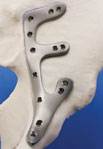Fusion Process from Abroad Increases Mold Performance
A select laser melting process has been developed overseas involving the fusion of a metallic powder by a scanning laser to produce complex, intricate 3-D parts that could impact the U.S. moldmaking industry
Share
Read Next
A select laser melting process has been developed overseas involving the fusion of a metallic powder by a scanning laser to produce complex, intricate 3-D parts that could impact the U.S. moldmaking industry. The layer-by-layer construction makes it possible to design and manufacture components that would otherwise be impractical or impossible to produce by traditional machining methods.
Concept Laser GmbH developed this process—called LaserCUSING® because of the combination of the words concept and fusing—for mold manufacturing as well as for the production of a wide range of parts as well as inserts for injection molding tools and inserts for pressure die casting.
The Process
According to Colin Cater, Sales Product Manager of ES Technology Limited (Daventry, England)—the distributor of LaserCusing technology—the process uses a powder together with an intense, solid-state laser to completely melt the metal and therefore produces a stress and deformation-free, fully dense part. “The powder material is applied to a component carrier in pre-determined thicknesses, and is then fused by the laser according to the CAD data for that specific layer or slice of the part,” Cater explains. “This process is repeated, layer by layer, until the finished part is produced.”
Advantages
The benefits to this process are numerous. “It enables the production of mold tool inserts and components with complex 3-D geometries,” Cater says. “Also, the ability to produce high resolution features such as conformal cooling channels and thin wall sections, which also have excellent mechanical properties, means that mold tool performance is improved and molding cycle times reduced. The resultant improvements in mold tool performance and reduced cycle times can mean, for example, that the same productivity could be obtained from a highly efficient, 12-cavity tool as would normally be achieved from a less efficient, 16-cavity tool. The smaller mold tool may allow for the use of a lower tonnage injection molding machine and therefore lower hourly running costs and lower costs per component.”
Endless Possibilities
Cater emphasizes that the precision of this process enables complex and intricate parts to be produced with conformal cooling channels as small as 1.0mm in diameter being achieved together with thin wall sections. “These attributes open up many new possibilities for mold tool designers,” Cater says. “Add to this the fact that the process produces parts using DIN standard tool steels—and in the case of the M2 cusing also aluminum and titanium—this process can be used to produce parts for a wide range of industries and applications.”
Related Content
-
Advantages and Disadvantages of Copper and Graphite Electrodes
Both copper and graphite provide approximately the same end result, so it is important for a shop to consider the advantages and disadvantages of each material in order to discover what would work best in their shop floor environment.
-
How to Eliminate Chatter
Here are techniques commonly used to combat chatter and guidelines to establish a foundation for optimizing the moldmaking process.
-
Machining Center Spindles: What You Need to Know
Why and how to research spindle technology before purchasing a machining center.






.png;maxWidth=300;quality=90)





